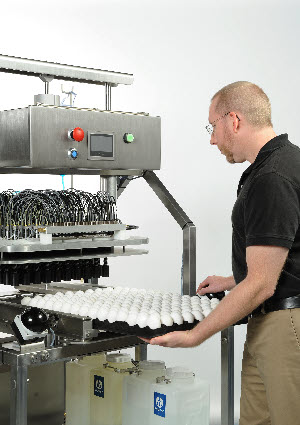



New Biodevice Praised at IPE
US - Pfizer Animal Health Global Poultry's new in ovo vaccination device, which was officially unveiled at IPE, could help improve operations at smaller hatcheries, according to one of the device's trial participants.Marciano Régis Tonus, agribusiness director of Frango Seva, in Pato Branco, Brazil, spent a month trialling the new Embrex® Inovoject® m, a semi-automated device designed specifically for hatcheries that do not have the floor space or throughput to accommodate one of the larger, fully automated Embrex Inovoject devices. Processing greater than 800,000 eggs throughout the trial, Mr Tonus is pleased with the results.
He said: "I believe that all hatcheries handling about the same number of eggs as this hatchery would be able to use a machine like Inovoject m. It's small, easy to use and it's simple."
Mr Tonus explained that the company had been using subcutaneous vaccination before trialling the in ovo technology.
"The most common problem we have with subcutaneous vaccination is due to the people's welfare. They sometimes develop health problems because of the repetition of the subcutaneous injection process. For example, problems in their arms because of the position they have to adopt for the process," he said.

Speaking at the launch meeting in Atlanta, Melinda Freson, Senior Manager, Global BioDevices at Pfizer Global Poultry, said the new device was developed in response to market needs.
She explained: "In ovo vaccination has a number of advantages over subcutaneous vaccination on day of hatch: it provides the earliest possible immunity against disease challenge, it is accurate and reliable, less stressful for chicks, less labor intensive and allows quicker delivery of chicks to the grow-out environment. Until now, these advantages have only been available to the larger producers."
Said Mr Tonus, Inovoject m is able to reduce the distance between the small companies and the big companies in Brazil by giving them an opportunity to use new technology.
According to Ms Freson, Inovoject m is likely to attract particular attention from producers in emerging markets who want to improve operational efficiencies in addition to the quality of the end product.
"We have conducted a number of trials around the world in different device configurations and the reaction has been very positive," explained Ms Freson.
Inovoject m can handle between 12,000 and 20,000 eggs per hour and includes the same injection technology that has made Embrex Inovoject the leading name in commercial in ovo vaccination worldwide. Each Inovoject m is available with the world-renowned Embrex service model.
Mr Tonus stated, "I am really happy that Pfizer asked us to do the trial and we are doing our best to create a good environment in the hatchery and in the field. They are doing their best to help us get the best possible results in the field."












